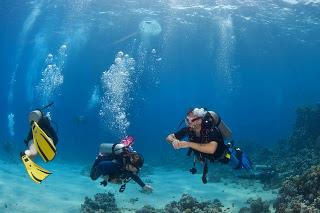
One of the dangers of scuba diving is the absorption of nitrogen into the bloodstream, as too much nitrogen causes decompression sickness. For this reason, dive table calculations are taught in any basic scuba diving course. Through these calculations, a diver can track how much nitrogen her body has absorbed on a given dive, and therefore plan her time on the surface and her next dive within the bounds of safety.
Monitor your bottom time on your first dive, taking note of both the deepest depth and the time spent there. Either you or your dive buddy needs a dive watch to do this.
Round up the depth and time figures to the nearest 5 for safety and utilize these numbers to determine your nitrogen class on the dive table. A dive with 18 minutes of bottom time at 95 feet should be rounded up to 20 minutes and 100 feet, yielding a class of "F."
Monitor your surface interval, or the time spent between the first dive and the second dive of the day. Utilize this number to determine your new, reduced class. After two hours on the surface, you should have dropped to class "D."
Inquire about the maximum depth of the day’s second dive and utilize this figure (rounded up for safety) to determine how much bottom time is safe for the second dive. If you spent two hours on the surface and the next dive bottoms at 65 feet, round up to 70 feet. In this example, the table indicates a maximum safe bottom time is 25 minutes and a residual nitrogen time of 20 minutes.
Add your residual nitrogen time to your actual bottom time to determine your new nitrogen class. With 20 minutes of residual nitrogen time and all 25 minutes spent on the bottom, your total nitrogen time is 45 minutes. Fed back into the table, this indicates a new nitrogen class of "I."
Repeat the procedure in Steps 3 and 4 to determine the safe diving parameters for a third dive.
Thanks to ehow
Kathy Dowsett
www.kirkscubagear.com